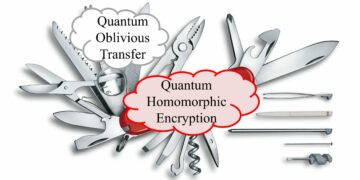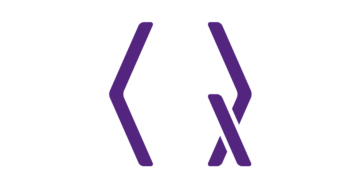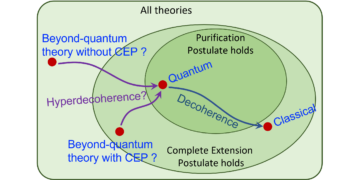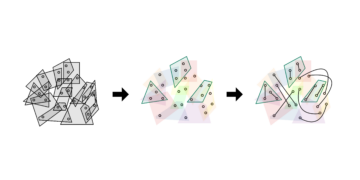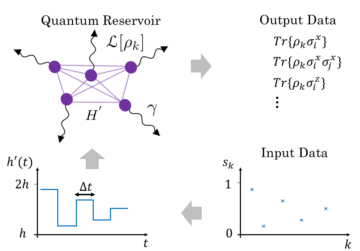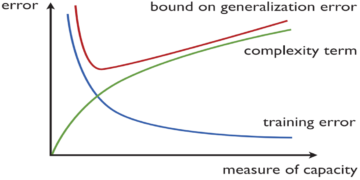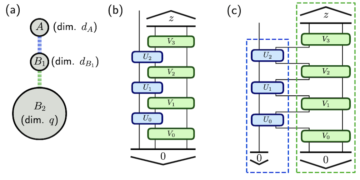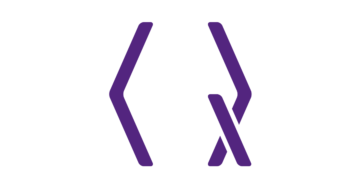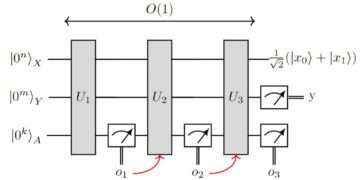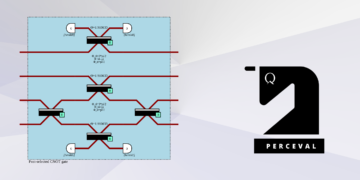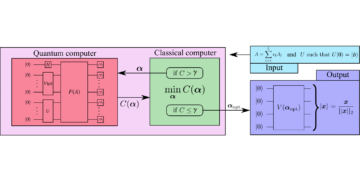Computational Research Division, Lawrence Berkeley National Laboratory, Berkeley, California 94720, USA
Find this paper interesting or want to discuss? Scite or leave a comment on SciRate.
Abstract
Emerging quantum hardware provides new possibilities for quantum simulation. While much of the research has focused on simulating closed quantum systems, the real-world quantum systems are mostly open. Therefore, it is essential to develop quantum algorithms that can effectively simulate open quantum systems. Here we present an adaptive variational quantum algorithm for simulating open quantum system dynamics described by the Lindblad equation. The algorithm is designed to build resource-efficient ansatze through the dynamical addition of operators by maintaining the simulation accuracy. We validate the effectiveness of our algorithm on both noiseless simulators and IBM quantum processors and observe good quantitative and qualitative agreement with the exact solution. We also investigate the scaling of the required resources with system size and accuracy and find polynomial behavior. Our results demonstrate that near-future quantum processors are capable of simulating open quantum systems.
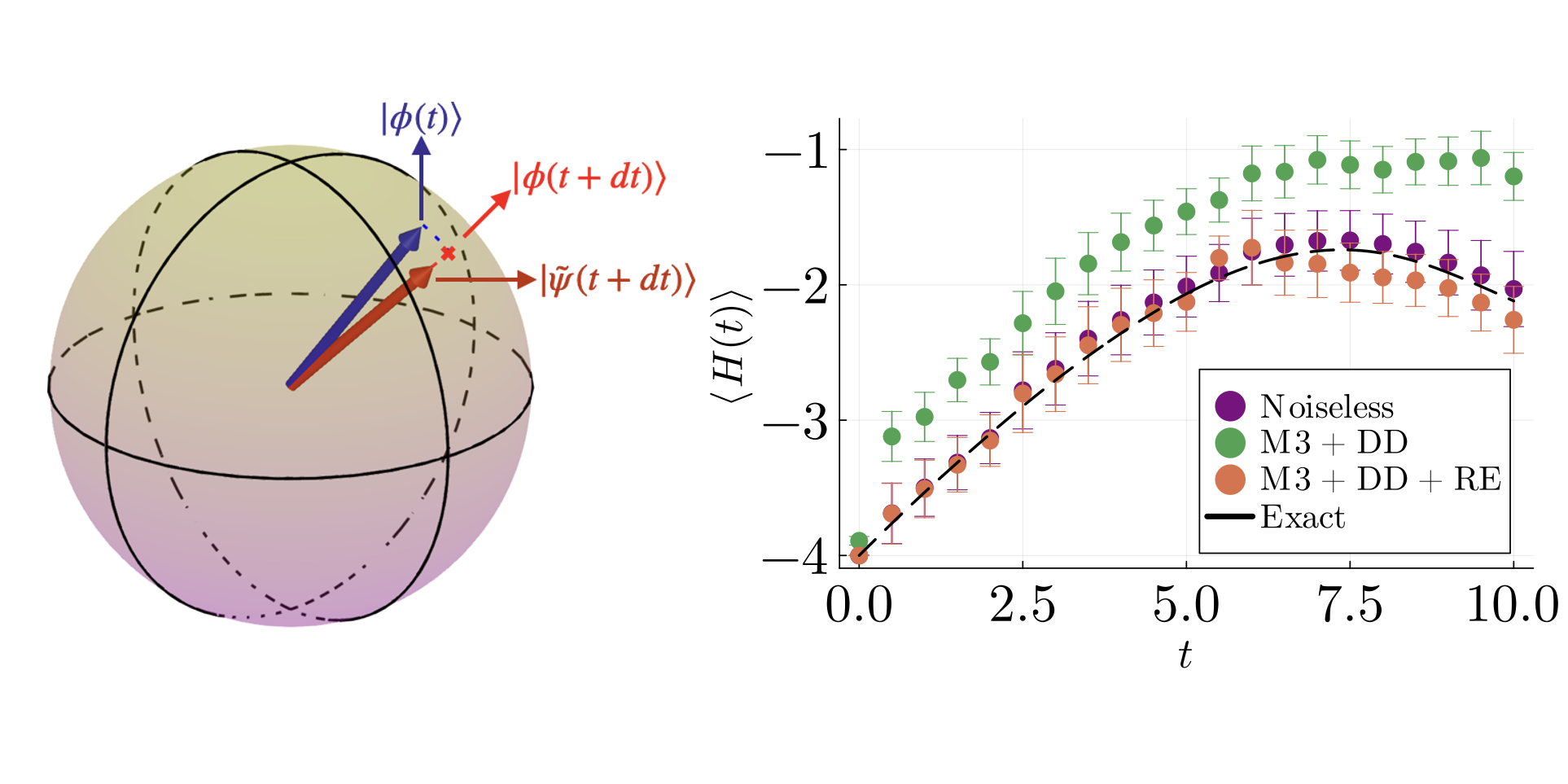
Featured image: How a non-unitary evolution is simulated using a unitary
Popular summary
In our work, we present a compact approach for simulating the open-quantum-system dynamics using a time-dependent adaptive variational method. The proposed algorithm constructs resource-efficient ansätze through the dynamical addition of operators by maintaining the simulation accuracy, providing a NISQ-friendly (Noisy Intermediate-Scale Quantum) alternatives to existing algorithms. We put this algorithm to the test on both noiseless simulators and actual IBM quantum processors, and the results exhibit good agreement with the exact solutions. Additionally, we demonstrate that the necessary resources scale reasonably with the increase in system size and precision.
Our results suggest that near-future quantum processors are capable of simulating open quantum systems. As quantum hardware continues to improve, we anticipate that our algorithm will open up new avenues for the practical simulation of open quantum systems in the NISQ era.
► BibTeX data
► References
[1] Heinz-Peter Breuer and Francesco Petruccione. “The theory of open quantum systems”. Oxford University Press. (2002).
https://doi.org/10.1093/acprof:oso/9780199213900.001.0001
[2] Ulrich Weiss. “Quantum dissipative systems”. Volume 13. World scientific. (2012).
https://doi.org/10.1142/8334
[3] Daniel A. Lidar. “Lecture notes on the theory of open quantum systems” (2020). arXiv:1902.00967.
arXiv:1902.00967
[4] Hendrik Weimer, Augustine Kshetrimayum, and Román Orús. “Simulation methods for open quantum many-body systems”. Rev. Mod. Phys. 93, 015008 (2021).
https://doi.org/10.1103/RevModPhys.93.015008
[5] Suguru Endo, Jinzhao Sun, Ying Li, Simon C. Benjamin, and Xiao Yuan. “Variational quantum simulation of general processes”. Phys. Rev. Lett. 125, 010501 (2020).
https://doi.org/10.1103/PhysRevLett.125.010501
[6] Zixuan Hu, Rongxin Xia, and Sabre Kais. “A quantum algorithm for evolving open quantum dynamics on quantum computing devices”. Sci. Rep. 10, 3301 (2020).
https://doi.org/10.1038/s41598-020-60321-x
[7] Yuchen Wang, Ellen Mulvihill, Zixuan Hu, Ningyi Lyu, Saurabh Shivpuje, Yudan Liu, Micheline B Soley, Eitan Geva, Victor S Batista, and Sabre Kais. “Simulating open quantum system dynamics on NISQ computers with generalized quantum master equations”. J. Chem. Theory Comput. (2023).
https://doi.org/10.1021/acs.jctc.3c00316
[8] Nishchay Suri, Joseph Barreto, Stuart Hadfield, Nathan Wiebe, Filip Wudarski, and Jeffrey Marshall. “Two-Unitary Decomposition Algorithm and Open Quantum System Simulation”. Quantum 7, 1002 (2023).
https://doi.org/10.22331/q-2023-05-15-1002
[9] Nathalie P de Leon, Kohei M Itoh, Dohun Kim, Karan K Mehta, Tracy E Northup, Hanhee Paik, B S Palmer, N Samarth, Sorawis Sangtawesin, and D W Steuerman. “Materials challenges and opportunities for quantum computing hardware”. Science 372 (2021).
https://doi.org/10.1126/science.abb28
[10] Michael A Nielsen and Isaac Chuang. “Quantum computation and quantum information”. American Association of Physics Teachers. (2002).
https://doi.org/10.1017/CBO9780511976667
[11] C L Degen, F Reinhard, and P Cappellaro. “Quantum sensing”. Rev. Mod. Phys. 89, 035002 (2017).
https://doi.org/10.1103/RevModPhys.89.035002
[12] Christian D Marciniak, Thomas Feldker, Ivan Pogorelov, Raphael Kaubruegger, Denis V Vasilyev, Rick van Bijnen, Philipp Schindler, Peter Zoller, Rainer Blatt, and Thomas Monz. “Optimal metrology with programmable quantum sensors”. Nature 603, 604–609 (2022).
https://doi.org/10.1038/s41586-022-04435-4
[13] Elisabetta Collini, Cathy Y Wong, Krystyna E Wilk, Paul M G Curmi, Paul Brumer, and Gregory D Scholes. “Coherently wired light-harvesting in photosynthetic marine algae at ambient temperature”. Nature 463, 644–647 (2010).
https://doi.org/10.1038/nature08811
[14] Andrea Mattioni, Felipe Caycedo-Soler, Susana F Huelga, and Martin B Plenio. “Design principles for Long-Range energy transfer at room temperature”. Phys. Rev. X 11, 041003 (2021).
https://doi.org/10.1103/PhysRevX.11.041003
[15] Xiaojun Yao. “Open quantum systems for quarkonia”. Int. J. Mod. Phys. A 36, 2130010 (2021).
https://doi.org/10.1142/S0217751X21300106
[16] Volkhard May. “Charge and energy transfer dynamics in molecular systems”. Wiley-VCH. Weinheim (2011).
https://doi.org/10.1002/9783527633791
[17] Simon J. Devitt. “Performing quantum computing experiments in the cloud”. Phys. Rev. A 94, 032329 (2016).
https://doi.org/10.1103/PhysRevA.94.032329
[18] Wibe A de Jong, Mekena Metcalf, James Mulligan, Mateusz Płoskoń, Felix Ringer, and Xiaojun Yao. “Quantum simulation of open quantum systems in heavy-ion collisions”. Phys. Rev. D 104, L051501 (2021).
https://doi.org/10.1103/PhysRevD.104.L051501
[19] Mekena Metcalf, Jonathan E Moussa, Wibe A de Jong, and Mohan Sarovar. “Engineered thermalization and cooling of quantum many-body systems”. Phys. Rev. Res. 2, 023214 (2020).
https://doi.org/10.1103/PhysRevResearch.2.023214
[20] Dmitri Maslov, Jin-Sung Kim, Sergey Bravyi, Theodore J Yoder, and Sarah Sheldon. “Quantum advantage for computations with limited space”. Nat. Phys. 17, 894–897 (2021).
https://doi.org/10.1038/s41567-021-01271-7
[21] Lindsay Bassman, Miroslav Urbanek, Mekena Metcalf, Jonathan Carter, Alexander F Kemper, and Wibe A de Jong. “Simulating quantum materials with digital quantum computers”. Quantum Sci. Technol. 6, 043002 (2021).
https://doi.org/10.1088/2058-9565/ac1ca6
[22] Miroslav Urbanek, Benjamin Nachman, Vincent R Pascuzzi, Andre He, Christian W Bauer, and Wibe A de Jong. “Mitigating depolarizing noise on quantum computers with Noise-Estimation circuits”. Phys. Rev. Lett. 127, 270502 (2021).
https://doi.org/10.1103/PhysRevLett.127.270502
[23] Katherine Klymko, Carlos Mejuto-Zaera, Stephen J Cotton, Filip Wudarski, Miroslav Urbanek, Diptarka Hait, Martin Head-Gordon, K Birgitta Whaley, Jonathan Moussa, Nathan Wiebe, Wibe A de Jong, and Norm M Tubman. “Real-Time evolution for ultracompact hamiltonian eigenstates on quantum hardware”. PRX Quantum 3, 020323 (2022).
https://doi.org/10.1103/PRXQuantum.3.020323
[24] Robin Harper and Steven T Flammia. “Fault-Tolerant logical gates in the IBM quantum experience”. Phys. Rev. Lett. 122, 080504 (2019).
https://doi.org/10.1103/PhysRevLett.122.080504
[25] Bibek Pokharel and Daniel A Lidar. “Demonstration of algorithmic quantum speedup”. Phys. Rev. Lett. 130, 210602 (2023).
https://doi.org/10.1103/PhysRevLett.130.210602
[26] Bibek Pokharel and Daniel Lidar. “Better-than-classical grover search via quantum error detection and suppression” (2022). arXiv:2211.04543.
arXiv:2211.04543
[27] A Kossakowski. “On quantum statistical mechanics of non-hamiltonian systems”. Rep. Math. Phys. 3, 247–274 (1972).
https://doi.org/10.1016/0034-4877(72)90010-9
[28] G Lindblad. “On the generators of quantum dynamical semigroups”. Commun. Math. Phys. 48, 119–130 (1976).
https://doi.org/10.1007/BF01608499
[29] Vittorio Gorini, Alberto Frigerio, Maurizio Verri, Andrzej Kossakowski, and E C G Sudarshan. “Properties of quantum markovian master equations”. Rep. Math. Phys. 13, 149–173 (1978).
https://doi.org/10.1016/0034-4877(78)90050-2
[30] Zixuan Hu, Kade Head-Marsden, David A Mazziotti, Prineha Narang, and Sabre Kais. “A general quantum algorithm for open quantum dynamics demonstrated with the Fenna-Matthews-Olson complex”. Quantum 6, 726 (2022).
https://doi.org/10.22331/q-2022-05-30-726
[31] Brian Rost, Lorenzo Del Re, Nathan Earnest, Alexander F. Kemper, Barbara Jones, and James K. Freericks. “Demonstrating robust simulation of driven-dissipative problems on near-term quantum computers” (2021). arXiv:2108.01183.
arXiv:2108.01183
[32] Hirsh Kamakari, Shi-Ning Sun, Mario Motta, and Austin J Minnich. “Digital quantum simulation of open quantum systems using quantum Imaginary–Time evolution”. PRX Quantum 3, 010320 (2022).
https://doi.org/10.1103/PRXQuantum.3.010320
[33] José D Guimarães, James Lim, Mikhail I Vasilevskiy, Susana F Huelga, and Martin B Plenio. “Noise-Assisted digital quantum simulation of open systems using partial probabilistic error cancellation”. PRX Quantum 4, 040329 (2023).
https://doi.org/10.1103/PRXQuantum.4.040329
[34] Juha Leppäkangas, Nicolas Vogt, Keith R Fratus, Kirsten Bark, Jesse A Vaitkus, Pascal Stadler, Jan-Michael Reiner, Sebastian Zanker, and Michael Marthaler. “Quantum algorithm for solving open-system dynamics on quantum computers using noise”. Phys. Rev. A 108, 062424 (2023).
https://doi.org/10.1103/PhysRevA.108.062424
[35] Hefeng Wang, S Ashhab, and Franco Nori. “Quantum algorithm for simulating the dynamics of an open quantum system”. Phys. Rev. A 83, 062317 (2011).
https://doi.org/10.1103/PhysRevA.83.062317
[36] John Preskill. “Quantum computing in the NISQ era and beyond”. Quantum 2, 79 (2018).
https://doi.org/10.22331/q-2018-08-06-79
[37] Yangchao Shen, Xiang Zhang, Shuaining Zhang, Jing-Ning Zhang, Man-Hong Yung, and Kihwan Kim. “Quantum implementation of the unitary coupled cluster for simulating molecular electronic structure”. Phys. Rev. A 95, 020501 (2017).
https://doi.org/10.1103/PhysRevA.95.020501
[38] Sam McArdle, Tyson Jones, Suguru Endo, Ying Li, Simon C Benjamin, and Xiao Yuan. “Variational ansatz-based quantum simulation of imaginary time evolution”. npj Quantum Information 5, 75 (2019).
https://doi.org/10.1038/s41534-019-0187-2
[39] Niladri Gomes, Anirban Mukherjee, Feng Zhang, Thomas Iadecola, Cai-Zhuang Wang, Kai-Ming Ho, Peter P. Orth, and Yong-Xin Yao. “Adaptive variational quantum imaginary time evolution approach for ground state preparation”. Advanced Quantum Technologies 4, 2100114 (2021).
https://doi.org/10.1002/qute.202100114
[40] Feng Zhang, Niladri Gomes, Yongxin Yao, Peter P Orth, and Thomas Iadecola. “Adaptive variational quantum eigensolvers for highly excited states”. Physical Review B 104, 075159 (2021).
https://doi.org/10.1103/PhysRevB.104.075159
[41] João C. Getelina, Niladri Gomes, Thomas Iadecola, Peter P. Orth, and Yong-Xin Yao. “Adaptive variational quantum minimally entangled typical thermal states for finite temperature simulations”. SciPost Phys. 15, 102 (2023).
https://doi.org/10.21468/SciPostPhys.15.3.102
[42] Hans C Fogedby, Anders B Eriksson, and Lev V Mikheev. “Continuum limit, galilean invariance, and solitons in the quantum equivalent of the noisy burgers equation”. Physical review letters 75, 1883 (1995).
https://doi.org/10.1103/PhysRevLett.75.1883
[43] Yong-Xin Yao, Niladri Gomes, Feng Zhang, Cai-Zhuang Wang, Kai-Ming Ho, Thomas Iadecola, and Peter P Orth. “Adaptive variational quantum dynamics simulations”. PRX Quantum 2, 030307 (2021).
https://doi.org/10.1103/PRXQuantum.2.030307
[44] Anurag Mishra, Tameem Albash, and Daniel A Lidar. “Finite temperature quantum annealing solving exponentially small gap problem with non-monotonic success probability”. Nat. Commun. 9, 2917 (2018).
https://doi.org/10.1038/s41467-018-05239-9
[45] Ben W Reichardt. “The quantum adiabatic optimization algorithm and local minima”. In Proceedings of the thirty-sixth annual ACM symposium on Theory of computing. Pages 502–510. STOC ’04New York, NY, USA (2004). Association for Computing Machinery.
https://doi.org/10.1145/1007352.1007428
[46] Roger A Horn and Charles R Johnson. “Topics in matrix analysis, 1991”. Cambridge University Presss, Cambridge 37, 39 (1991).
https://doi.org/10.1017/CBO9780511840371
[47] Ka Wa Yip, Tameem Albash, and Daniel A Lidar. “Quantum trajectories for time-dependent adiabatic master equations”. Phys. Rev. A 97, 022116 (2018).
https://doi.org/10.1103/PhysRevA.97.022116
[48] Todd A Brun. “A simple model of quantum trajectories”. Am. J. Phys. 70, 719–737 (2002).
https://doi.org/10.1119/1.1475328
[49] Crispin Gardiner, P Zoller, and Peter Zoller. “Quantum noise: A handbook of markovian and Non-Markovian quantum stochastic methods with applications to quantum optics”. Springer Science & Business Media. (2004). url: https://link.springer.com/book/9783540223016.
https://link.springer.com/book/9783540223016
[50] Xiao Yuan, Suguru Endo, Qi Zhao, Ying Li, and Simon C Benjamin. “Theory of variational quantum simulation”. Quantum 3, 191 (2019).
https://doi.org/10.22331/q-2019-10-07-191
[51] Suguru Endo, Iori Kurata, and Yuya O. Nakagawa. “Calculation of the green’s function on near-term quantum computers”. Phys. Rev. Research 2, 033281 (2020).
https://doi.org/10.1103/PhysRevResearch.2.033281
[52] J K L MacDonald. “On the modified ritz variation method”. Phys. Rev. 46, 828–828 (1934).
https://doi.org/10.1103/PhysRev.46.828
[53] Kosuke Mitarai and Keisuke Fujii. “Methodology for replacing indirect measurements with direct measurements”. Phys. Rev. Res. 1, 013006 (2019).
https://doi.org/10.1103/PhysRevResearch.1.013006
[54] Guang Hao Low and Isaac L Chuang. “Optimal hamiltonian simulation by quantum signal processing”. Phys. Rev. Lett. 118, 010501 (2017).
https://doi.org/10.1103/PhysRevLett.118.010501
[55] Lorenzo Del Re, Brian Rost, A F Kemper, and J K Freericks. “Driven-dissipative quantum mechanics on a lattice: Simulating a fermionic reservoir on a quantum computer”. Phys. Rev. B Condens. Matter 102, 125112 (2020).
https://doi.org/10.1103/PhysRevB.102.125112
[56] Daan Camps, Lin Lin, Roel Van Beeumen, and Chao Yang. “Explicit quantum circuits for block encodings of certain sparse matrices” (2023). arXiv:2203.10236.
arXiv:2203.10236
[57] Ho Lun Tang, V.O. Shkolnikov, George S. Barron, Harper R. Grimsley, Nicholas J. Mayhall, Edwin Barnes, and Sophia E. Economou. “Qubit-adapt-vqe: An adaptive algorithm for constructing hardware-efficient ansätze on a quantum processor”. PRX Quantum 2, 020310 (2021).
https://doi.org/10.1103/PRXQuantum.2.020310
[58] V O Shkolnikov, Nicholas J Mayhall, Sophia E Economou, and Edwin Barnes. “Avoiding symmetry roadblocks and minimizing the measurement overhead of adaptive variational quantum eigensolvers”. Quantum 7, 1040 (2023).
https://doi.org/10.22331/q-2023-06-12-1040
[59] Huo Chen and Daniel A Lidar. “Hamiltonian open quantum system toolkit”. Communications Physics 5, 1–10 (2022).
https://doi.org/10.1038/s42005-022-00887-2
[60] N G Dickson, M W Johnson, M H Amin, R Harris, F Altomare, A J Berkley, P Bunyk, J Cai, E M Chapple, P Chavez, F Cioata, T Cirip, P deBuen, M Drew-Brook, C Enderud, S Gildert, F Hamze, J P Hilton, E Hoskinson, K Karimi, E Ladizinsky, N Ladizinsky, T Lanting, T Mahon, R Neufeld, T Oh, I Perminov, C Petroff, A Przybysz, C Rich, P Spear, A Tcaciuc, M C Thom, E Tolkacheva, S Uchaikin, J Wang, A B Wilson, Z Merali, and G Rose. “Thermally assisted quantum annealing of a 16-qubit problem”. Nat. Commun. 4, 1903 (2013).
https://doi.org/10.1038/ncomms2920
[61] Sergio Boixo, Vadim N Smelyanskiy, Alireza Shabani, Sergei V Isakov, Mark Dykman, Vasil S Denchev, Mohammad H Amin, Anatoly Yu Smirnov, Masoud Mohseni, and Hartmut Neven. “Computational multiqubit tunnelling in programmable quantum annealers”. Nat. Commun. 7, 10327 (2016).
https://doi.org/10.1038/ncomms10327
[62] E J Crosson and D A Lidar. “Prospects for quantum enhancement with diabatic quantum annealing”. Nature Reviews Physics 3, 466–489 (2021).
https://doi.org/10.1038/s42254-021-00313-6
[63] Luis Pedro García-Pintos, Lucas T Brady, Jacob Bringewatt, and Yi-Kai Liu. “Lower bounds on quantum annealing times”. Phys. Rev. Lett. 130, 140601 (2023).
https://doi.org/10.1103/PhysRevLett.130.140601
[64] Humberto Munoz-Bauza, Huo Chen, and Daniel Lidar. “A double-slit proposal for quantum annealing”. npj Quantum Information 5, 51 (2019).
https://doi.org/10.1038/s41534-019-0160-0
[65] Ed Younis, Koushik Sen, Katherine Yelick, and Costin Iancu. “QFAST: Conflating search and numerical optimization for scalable quantum circuit synthesis”. In 2021 IEEE International Conference on Quantum Computing and Engineering (QCE). Pages 232–243. (2021).
https://doi.org/10.1109/QCE52317.2021.00041
[66] Aaron Szasz, Ed Younis, and Wibe De Jong. “Numerical circuit synthesis and compilation for Multi-State preparation”. In 2023 IEEE International Conference on Quantum Computing and Engineering (QCE). Volume 01, pages 768–778. IEEE (2023).
https://doi.org/10.1109/QCE57702.2023.00092
[67] Paul D. Nation, Hwajung Kang, Neereja Sundaresan, and Jay M. Gambetta. “Scalable mitigation of measurement errors on quantum computers”. PRX Quantum 2, 040326 (2021).
https://doi.org/10.1103/PRXQuantum.2.040326
[68] Nic Ezzell, Bibek Pokharel, Lina Tewala, Gregory Quiroz, and Daniel A Lidar. “Dynamical decoupling for superconducting qubits: A performance survey”. Phys. Rev. Appl. 20, 064027 (2023).
https://doi.org/10.1103/PhysRevApplied.20.064027
[69] Vinay Tripathi, Huo Chen, Mostafa Khezri, Ka-Wa Yip, E M Levenson-Falk, and Daniel A Lidar. “Suppression of crosstalk in superconducting qubits using dynamical decoupling”. Phys. Rev. Applied 18, 024068 (2022).
https://doi.org/10.1103/PhysRevApplied.18.024068
[70] Bibek Pokharel, Namit Anand, Benjamin Fortman, and Daniel A Lidar. “Demonstration of fidelity improvement using dynamical decoupling with superconducting qubits”. Phys. Rev. Lett. 121, 220502 (2018).
https://doi.org/10.1103/PhysRevLett.121.220502
[71] Lorenza Viola, Emanuel Knill, and Seth Lloyd. “Dynamical decoupling of open quantum systems”. Phys. Rev. Lett. 82, 2417–2421 (1999).
https://doi.org/10.1103/PhysRevLett.82.2417
[72] Niladri Gomes, David B Williams-Young, and Wibe A de Jong. “Computing the Many-Body green’s function with adaptive variational quantum dynamics”. J. Chem. Theory Comput. 19, 3313–3323 (2023).
https://doi.org/10.1021/acs.jctc.3c00150
[73] Reyhaneh Khasseh, Sascha Wald, Roderich Moessner, Christoph A. Weber, and Markus Heyl. “Active quantum flocks” (2023). arXiv:2308.01603.
arXiv:2308.01603
[74] Youngseok Kim, Andrew Eddins, Sajant Anand, Ken Xuan Wei, Ewout van den Berg, Sami Rosenblatt, Hasan Nayfeh, Yantao Wu, Michael Zaletel, Kristan Temme, and Abhinav Kandala. “Evidence for the utility of quantum computing before fault tolerance”. Nature 618, 500–505 (2023).
https://doi.org/10.1038/s41586-023-06096-3
[75] Ewout van den Berg, Zlatko K Minev, Abhinav Kandala, and Kristan Temme. “Probabilistic error cancellation with sparse Pauli–Lindblad models on noisy quantum processors”. Nat. Phys.Pages 1–6 (2023).
https://doi.org/10.1038/s41567-023-02042-2
[76] Xiaoming Sun, Guojing Tian, Shuai Yang, Pei Yuan, and Shengyu Zhang. “Asymptotically optimal circuit depth for quantum state preparation and general unitary synthesis”. IEEE Trans. Comput. Aided Des. Integr. Circuits Syst.Pages 1–1 (2023).
https://doi.org/10.1109/TCAD.2023.3244885
[77] Tom O’Haver. “A pragmatic introduction to signal processing with applications in scientific measurement” (2022).
[78] Thomas Steckmann, Trevor Keen, Efekan Kökcü, Alexander F. Kemper, Eugene F. Dumitrescu, and Yan Wang. “Mapping the metal-insulator phase diagram by algebraically fast-forwarding dynamics on a cloud quantum computer”. Phys. Rev. Res. 5, 023198 (2023).
https://doi.org/10.1103/PhysRevResearch.5.023198
Cited by
This Paper is published in Quantum under the Creative Commons Attribution 4.0 International (CC BY 4.0) license. Copyright remains with the original copyright holders such as the authors or their institutions.
- SEO Powered Content & PR Distribution. Get Amplified Today.
- PlatoData.Network Vertical Generative Ai. Empower Yourself. Access Here.
- PlatoAiStream. Web3 Intelligence. Knowledge Amplified. Access Here.
- PlatoESG. Carbon, CleanTech, Energy, Environment, Solar, Waste Management. Access Here.
- PlatoHealth. Biotech and Clinical Trials Intelligence. Access Here.
- Source: https://quantum-journal.org/papers/q-2024-02-13-1252/
- :has
- :is
- :not
- ][p
- $UP
- 001
- 01
- 1
- 10
- 102
- 1040
- 11
- 118
- 12
- 121
- 125
- 127
- 13
- 130
- 14
- 15%
- 16
- 17
- 19
- 1934
- 1995
- 1999
- 2%
- 20
- 2010
- 2011
- 2012
- 2013
- 2016
- 2017
- 2018
- 2019
- 2020
- 2021
- 2022
- 2023
- 21
- 22
- 23
- 24
- 25
- 26
- 27
- 28
- 29
- 30
- 31
- 32
- 33
- 34
- 35%
- 36
- 39
- 4
- 40
- 41
- 42
- 45
- 46
- 48
- 49
- 5
- 50
- 51
- 52
- 54
- 55
- 58
- 6
- 60
- 62
- 65
- 66
- 67
- 7
- 70
- 72
- 73
- 74
- 75
- 77
- 8
- 89
- 9
- 97
- a
- Aaron
- Able
- ABSTRACT
- access
- accuracy
- ACM
- actual
- adaptive
- addition
- Additionally
- advanced
- ADvantage
- affiliations
- Agreement
- Alexander
- algorithm
- algorithmic
- algorithms
- alireza
- also
- alternatives
- am
- Ambient
- American
- an
- analysis
- and
- andre
- andrea
- Andrew
- annual
- anticipate
- Application
- applications
- applied
- approach
- ARE
- artificial
- AS
- assisted
- Association
- At
- austin
- author
- authors
- avenues
- b
- before
- behavior
- being
- ben
- Benjamin
- Berkeley
- Beyond
- Block
- both
- bounds
- Break
- Brian
- build
- business
- but
- by
- california
- cambridge
- CAN
- capable
- carlos
- cathy
- certain
- challenges
- Charles
- chen
- christian
- circuit
- circuits
- closed
- Cloud
- Cluster
- comment
- Commons
- Communications
- compact
- complex
- computation
- computations
- computer
- computers
- computing
- Conference
- constructing
- constructs
- continues
- copyright
- coupled
- critical
- Daniel
- David
- de
- degen
- del
- demonstrate
- demonstrated
- Den
- depth
- described
- Design
- designed
- Detection
- develop
- Devices
- diagram
- digital
- direct
- discuss
- Division
- dynamics
- e
- earnest
- ed
- Edwin
- effectively
- effectiveness
- efficiently
- Electronic
- energy
- Engineering
- enhancement
- Environment
- equation
- equations
- Equivalent
- Era
- error
- Errors
- essential
- Ether (ETH)
- eugene
- evolution
- evolving
- exact
- excited
- exhibit
- existing
- experience
- experiments
- exponentially
- fault
- Feb
- fidelity
- Find
- finite
- focused
- For
- function
- gap
- Gates
- General
- generalized
- generators
- George
- good
- Green
- Ground
- hans
- Hardware
- Harvesting
- he
- here
- highly
- Hilton
- hold
- holders
- Hoskinson
- How
- However
- HTTPS
- i
- IBM
- ibm quantum
- IEEE
- image
- imaginary
- implementation
- improve
- improvement
- in
- Increase
- information
- institutions
- interact
- interest
- interesting
- International
- into
- Introduction
- investigate
- IT
- ivan
- jacob
- james
- JavaScript
- jeffrey
- John
- Johnson
- jonathan
- jones
- journal
- just
- Keen
- keith
- Key
- Kim
- known
- laboratory
- lawrence
- Leave
- li
- License
- lidar
- light
- LIMIT
- Limited
- lin
- lindsay
- local
- logical
- Low
- macdonald
- machinery
- maintaining
- many
- Marine
- Mario
- mark
- Martin
- master
- materials
- math
- Matrix
- Matter
- max-width
- May..
- measurement
- measurements
- mechanics
- Media
- Metcalf
- method
- methods
- Metrology
- Michael
- mikhail
- minimizing
- Mishra
- mitigation
- model
- models
- modified
- molecular
- Month
- mostly
- much
- Mukherjee
- multi-state
- nation
- National
- Nature
- necessary
- New
- nicholas
- Nicolas
- Noise
- Notes
- numerical
- NY
- observe
- of
- often
- oh
- on
- open
- operators
- opportunities
- optics
- optimal
- optimization
- or
- original
- Other
- our
- overhead
- Oxford
- oxford university
- pages
- Palmer
- Paper
- partial
- Paul
- performance
- Peter
- phase
- physical
- Physics
- plato
- Plato Data Intelligence
- PlatoData
- polynomial
- possibilities
- Practical
- pragmatic
- Precision
- preparation
- present
- press
- principles
- probability
- Problem
- problems
- Proceedings
- processes
- processing
- Processor
- processors
- programmable
- promise
- proposal
- proposed
- provides
- providing
- published
- publisher
- put
- Qi
- qualitative
- quantitative
- Quantum
- quantum algorithms
- Quantum Annealing
- Quantum Computer
- quantum computers
- quantum computing
- quantum information
- quantum materials
- Quantum Mechanics
- Quantum optics
- Quantum sensors
- quantum systems
- qubits
- R
- RE
- real world
- references
- remains
- required
- research
- Resources
- Results
- review
- Reviews
- Rich
- roadblocks
- Robin
- robust
- Room
- ROSE
- s
- Sam
- scalable
- Scale
- scaling
- SCI
- Science
- scientific
- Search
- sensors
- Signal
- Simon
- Simple
- simulate
- simulation
- simulations
- Size
- small
- solution
- Solutions
- Solving
- sophia
- Space
- sparse
- State
- States
- statistical
- Stephen
- steven
- storage
- structure
- success
- such
- suggest
- Sun
- suppression
- Survey
- symmetry
- Symposium
- synthesis
- system
- Systems
- T
- tang
- teachers
- technological
- Technologies
- test
- that
- The
- their
- theoretical
- theory
- therefore
- thermal
- this
- thomas
- Through
- time
- times
- Title
- to
- todd
- tolerance
- tom
- toolkit
- tracy
- trans
- transfer
- Trevor
- Turning
- typical
- under
- university
- URL
- USA
- using
- utility
- VALIDATE
- Vasil
- via
- vincent
- Viola
- volume
- W
- wang
- want
- we
- weiss
- What
- while
- will
- Wilson
- with
- wong
- Work
- world
- wu
- X
- xiao
- year
- YING
- york
- Yuan
- zephyrnet
- zhang
- Zhao

